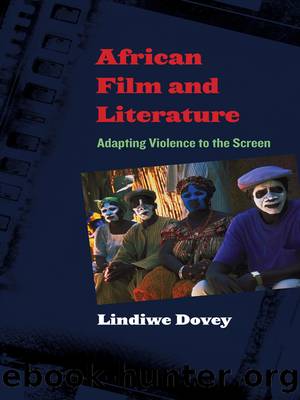African Film and Literature by Dovey Lindiwe;

Author:Dovey, Lindiwe;
Language: eng
Format: epub
Tags: Social Science/Sociology/General
Publisher: Columbia University Press
Published: 2011-08-16T00:00:00+00:00
Figure 5.2 Hanging sequence from Cry, the Beloved Country. (Images courtesy of Videovision Entertainment)
Many of the problems and debates raised in the novel persist in the South Africa of today as the country struggles to throw off the injustices of the past and to normalise itself. Problems such as unemployment, poverty, insufficient housing, inadequate educational opportunities, as well as, most evidently, the unacceptably high crime rate, remain crucially pertinent. In fact, reading the novel today inspires the uncanny feeling that, in terms of its portrayal of social ills, it might have been written in 1998 rather than 1948. (1996: 89)
The high rate of crime, which often involves extreme and apparently gratuitous violence, has resulted in calls to reinstate the death sentence, which was abolished when the ANC came into power. Roodt and Singh offer a critique of contemporary crime, but at the same time historicize it, and make a powerful case against a retributive system of justice which relies on the further sacrifice of life. In this sense, the film does not, as Berardinelli claims, simply show âthe path of tolerance and compassion that the leaders of South Africa have finally foundâ and thereby âquiet one of Paton's great concerns: that âwhen the white man turns to loving, the black man will have turned to hatingâ â (1995), but is admonitory, warning South Africans against a continuing lack of mutual tolerance. The choice to readapt and remake Cry in 1995 thus seems far from arbitrary, and not merely opportunistic.
At the U.S. premiere of the 1995 film, Nelson Mandela praised it for being a âmonument to the future,â and for bringing to the screen âsuch strong emotions about the terrible pastâ (Beittel 2003:70). By calling it a âmonument to the future,â Mandela suggests that the film concentrates not only on the âterrible pastâ but also addresses that âunfinished cultural business, unrefinable and perhaps finally unassimilable material that remains part of the cultural dialogueâ to which Braudy refers. And by pointing to the âstrong emotionsâ that the film evokes, Mandela recognizes its embodied as well as rational power. It is this power which accounts for the popular appeal of the novel, evident in the response of an early critic, who praises it for doing âwhat no discursive work in political science, sociology, economics, or anthropology could ever do; it makes us understand âhow it feelsâ to be a South African [in the 1940s]â (Collins 1953:46).
It is a power also evident in the 1951 film, which, although it makes use of some foreign actors and exhibits a mélange of influences (including that of the classical Hollywood style), contains some remarkable neorealist scenes. Cinematographer Robert Krasker captured the everyday life of people in the rural village of Nokweja (the equivalent of Ndotsheni in the novel) and in the slums of Johannesburg, in Pimville and Sophiatown. Handheld vérité shots show people in the Ixopo hills or in the city, traveling on trains, or trudging to work. We see people huddled at the window of a thatched hut to watch the rain; a woman with braided hair holding a child to her breast.
Download
This site does not store any files on its server. We only index and link to content provided by other sites. Please contact the content providers to delete copyright contents if any and email us, we'll remove relevant links or contents immediately.
The Power of Myth by Joseph Campbell & Bill Moyers(925)
Half Moon Bay by Jonathan Kellerman & Jesse Kellerman(908)
A Social History of the Media by Peter Burke & Peter Burke(878)
Inseparable by Emma Donoghue(843)
The Nets of Modernism: Henry James, Virginia Woolf, James Joyce, and Sigmund Freud by Maud Ellmann(736)
The Spike by Mark Humphries;(719)
The Complete Correspondence 1928-1940 by Theodor W. Adorno & Walter Benjamin(703)
A Theory of Narrative Drawing by Simon Grennan(702)
Ideology by Eagleton Terry;(655)
Bodies from the Library 3 by Tony Medawar(646)
World Philology by(645)
Culture by Terry Eagleton(641)
Farnsworth's Classical English Rhetoric by Ward Farnsworth(640)
A Reader’s Companion to J. D. Salinger’s The Catcher in the Rye by Peter Beidler(609)
Adam Smith by Jonathan Conlin(605)
Game of Thrones and Philosophy by William Irwin(590)
High Albania by M. Edith Durham(587)
Comic Genius: Portraits of Funny People by(581)
Monkey King by Wu Cheng'en(575)
